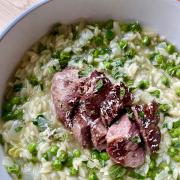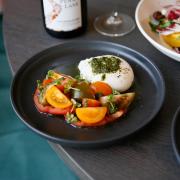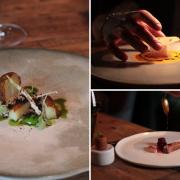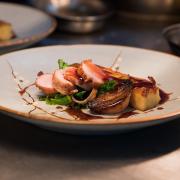Portsmouth Distillery has the perfect on-shore base in historic Fort Cumberland for their rums and gin. Viv Micklefield takes a tour
Stepping through the doors of a small distillery, its beating heart is where the alchemy takes place, when some simple ingredients combine to create a magical nectar.
However, while many an artisan drinks producer has joined the country's ginaissance in recent years, at the Portsmouth Distillery it's the sweet aroma of fermented sugar syrup that assaults the senses. It signals the latest batch of rum is underway.
The gleaming copper still being used is only a year old, but the method employed in producing the unique range of rums, and the gin which is also made here, goes back centuries providing the perfect fit with the distillery's unusual surroundings.
Steeped in naval history, Fort Cumberland stands to the east of Portsmouth Dockyard and bears testament to its 18th century reconstruction. The mighty defensive walls guarding the entrance to Langstone Harbour form a pentagon that currently houses the Nautical Archaeology Society as well as Historic England's research establishment.
Where once ammunition for Nelson's fleet was stored just yards from the water's edge, a burgeoning business now flows, thanks to the passion of its founders for their favourite tipple.
"We wanted to produce a rum with a story behind it," says Vince Noyce, who has assumed the role of chief distiller. "We came to be in this wonderful location as a result of approaching Portsmouth City Council to see if they knew of any historic sites which might be available and Fort Cumberland was suggested. We had no idea this glorious bastion was here. These casements were empty. Historic England have been great landlords."
Also at the helm is Giles Collighan, another ex-naval officer and friend for many years, and a long-time Portsmouth resident. "Customers are always impressed as Fort Cumberland is not generally open to the public," says Giles. "Often the only way people get to see it is by coming to see us.
"Although we had to do a lot of work to bring it up to what you now see, this was reasonably superficial as water and electrics were already laid on."
Although, judging by how smooth their operation appears, the duo continue to invest considerable time and energy into fine tuning every detail. And this includes the branding which, from the outset has featured a logo with both their initials, as well as plenty of local references to reinforce the sense of provenance. It's something that they are keen to shout about.
With separate areas readied for production, bottling and storage, an essential piece of kit needed to be sourced, the main still. According to Vince, it has its own story.
"We've called this one Sophie Wu because that was the name of the wonderfully helpful lady we dealt with in China where we bought it from." He adds: "We had some fun putting it together as it [the still] came without any instructions!"
Having launched their first own label rum in December 2018, indeed the first rum ever to have been made in Portsmouth as far as is known, Vince explains that two variations are now produced over a period of between three and five weeks.
"Our 1968 white rum, is made using dehydrated sugar cane from Costa Rica. We make our own syrup which is fermented and then distilled twice. Typically the final yield is 20 per cent of what you start with.
"We also produce a spiced rum having added extra ingredients to the first distillation before running it through the still a second time."
Interestingly, one of these additions to the caramel-coloured Cinnabar spice rum, appropriately called after the moth by the same name that resides at the fort, is a splash of dry gin. This is also made on the premises, making use of the still's spare capacity in-between rum runs, and is a natural extension to their spirits range.
"A 500-litre still is large for a start-up and you can't have this sitting idle," says Vince. "Since coming here we've found elderflowers growing on the roof, plus sea radish and gorse flowers along the coast, so set about creating a recipe based around those three key ingredients.
"It took around three months to develop and I ended up with juniper plus 15 botanicals. At the crank of a handle we can produce enough gin to fill 700 bottles in 36 to 38 hours, which makes economic sense. The result is a complex yet smooth gin with lots of flavour and we're very proud of it."
While Fort Gin provides a ready boost to cash flow, the team whose third member Dich Oatley has forged a career in the drinks industry, is taking a longer term view; the plan being to one day produce an aged rum. As Giles explains, leading the way into the cellar, it will take five years before they can sell what's known in the trade as a sipping rum. Quietly maturing in wooden barrels, this will remain undisturbed until ready to take-on the world's premium brands - something that he and Vince know plenty about as their previous start-up was The Rum Club, an online community of like-minded aficionados. Again, Giles points out, how well suited the fort is to their present needs.
"This used to be an old magazine that supplied powder and shot to the gun casements, the temperature in here stays the same all year round, so it's ideal.
"We plan to fill one barrel a month and, so far, there's just the one. These are made of charred oak that once held bourbon and there's a constant supply because the American whiskey producers are only allowed to use the barrels once. They each hold 200 litres and after the rum is diluted to the 41 proof required, will provide 350 bottles."
For those too impatient to wait to sample the aged rum, then the distillery's current spirit range is already making waves in numerous local venues. Southsea's speakeasy The Blind Tiger, according to Vince, "have smashed out some brilliant cocktails". Admitting that it makes a great Mojito, his preferred way to serve the delicate white rum is as an aperitif, over ice. The gin meanwhile is best accompanied with a light tonic.
Reflecting on their "amazing journey" so far, the business is already growing at such a rate that another casement is soon set to be taken over to make way for a bigger reception for customer tours.
Some might say that landing as they have done at Fort Cumberland is serendipity. Suggesting, that for these budding entrepreneurs, it mightn't be too long before their ship really does come in.
www.theportsmouthdistillery.com
More…
- Why Hampshire is becoming the English Champagne region - After a great grape harvest in 2018 Hampshire is fast becoming the English Champagne region



























